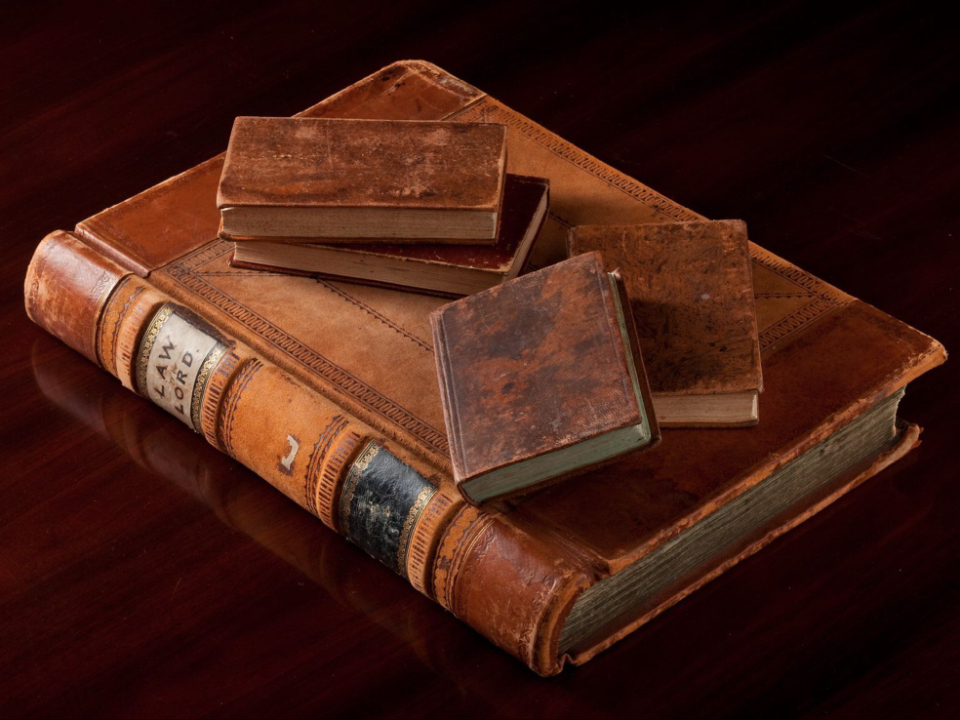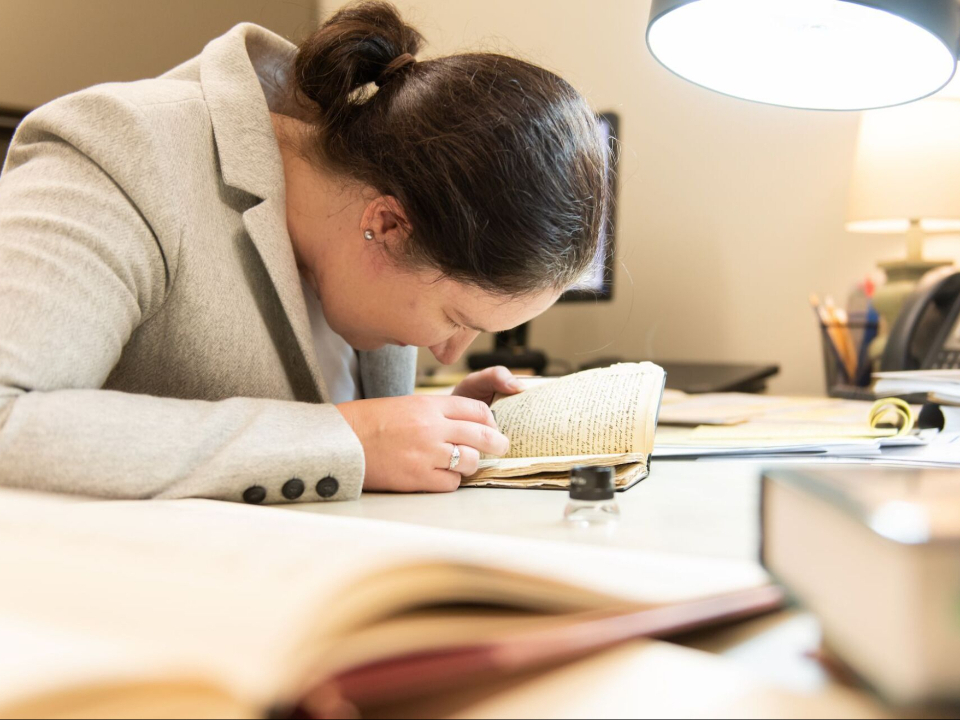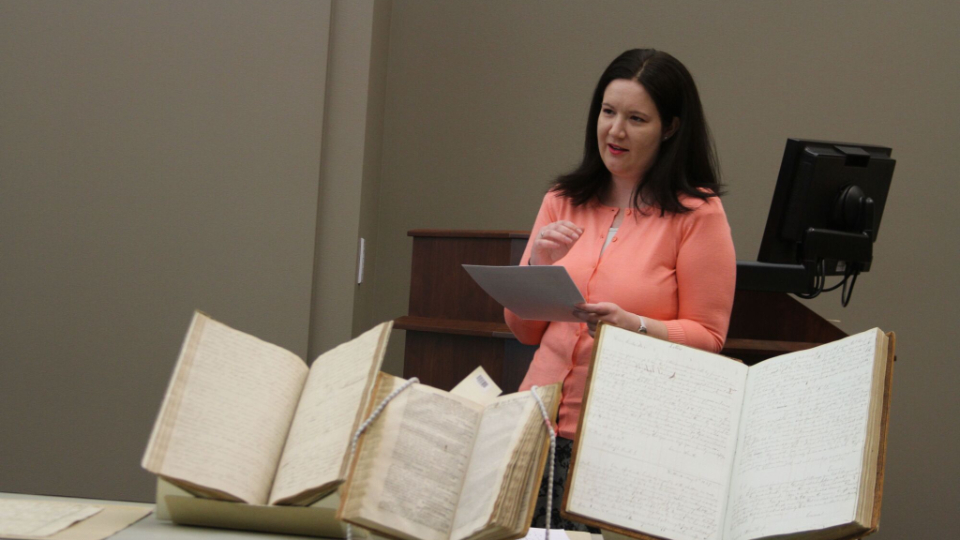
Joseph-Smith-Papers-Nauvoo
The large book, the first of Joseph Smith’s Nauvoo journals, is titled “The Book of the Law of the Lord” and covers December 1841 through December 1842. It contains tithing records from the Nauvoo era of Church history. Photo by Welden C. Andersen, courtesy of Church News.All rights reserved.This story appears here courtesy of TheChurchNews.com. It is not for use by other media.
By Trent Toone, Church News
In July 1838, Joseph Smith received a revelation on tithing, which was later canonized as Section 119 of the Doctrine and Covenants. The revelation directed the Saints to consecrate all their surplus property to The Church of Jesus Christ of Latter-day Saints and thereafter pay one-tenth of their interest annually.
The revelation provided the solution for funding and building the Nauvoo Temple as thousands of Latter-day Saints in the 1840s contributed their money and goods to the effort, said Elizabeth Kuehn, a historian and editor on the Joseph Smith Papers.
“In October 1840, the men of the Church had agreed to donate a portion of their time, every 10th day, to work on the temple. Over time, tithing in Nauvoo became divided between property tithing, which was paid in money or goods, and labor tithing, which was meant to be paid by working on the temple,” she said. “This was the means by which the temple would be built, Church leaders would be saved from substantial debt, and all would be asked to contribute what they could in property and labor.”
All tithing donations were carefully recorded in a record book known as the Book of the Law of the Lord.
“This was a record book of salvific importance and eternal significance,” Kuehn said. “The names and donations recorded in the Book of the Law of the Lord determined an individual’s faithfulness, whether they had paid their tithing in full, as well as their access to the temple.”
Hundreds of pages of these Nauvoo, Illinois, era tithing records, with images and searchable transcripts, are now available for free on the Joseph Smith Papers website.
Kuehn first announced the online publication of the Nauvoo-era tithing records while presenting at the Joseph Smith Papers conference in September. The last of the 27 Joseph Smith Papers volumes was published in June.
The tithing records are part of a series the papers project started in 2020 called the financial series, which features the Prophet’s financial papers.

Joseph-Smith-Papers-Nauvoo
Elizabeth A. Kuehn, a historian and editor with the Joseph Smith Papers, uses a loupe to examine the tiny handwriting in the 1842 diary of John D. Lee. Photo by Nicole Fernley, courtesy of Church News.All rights reserved.“We have around 1,000 pages of Nauvoo-era tithing records from 1841 to January 1846,” Kuehn said. “Half of these are for the period in which Joseph Smith was trustee for the Church and oversaw tithing donations.”
The records are available to view on the Joseph Smith Papers website:
- The introduction to the Book of the Law of the Lord.
- Images and transcript of the main book, Book A.
- Book B.
- Along with tithing records, the Book of the Law of the Lord also features Joseph Smith’s journal entries.
The records contain hundreds of examples of Saints paying tithing in various forms, from small and large amounts of money to donating a wide variety of goods, including fabric, pieces of clothing, garden produce, cattle, horses, wagons, rifles, jewelry, bedding, books, newspapers, quilts and baskets, to name a few. No matter how big or small a donation, the temple recorder and other clerks noted the donation and made sure it was used for the benefit of the Church and construction of the temple, Kuehn said.
“If I have learned anything from studying Nauvoo tithing records, it is that no donation, no matter how small, was considered insignificant,” she said. “Truly the Saints proved that by small and simple things are great things brought to pass.”
Examples of Tithing Donations
In March 1842, a woman named Mary Parsons gave seven baskets as her tithing donation.
John H. Reid, one of the men who worked on the temple, offered his carpentry tools, which were valued at $44. The tools were accepted and then returned to him so he could continue working on the temple.
Another temple worker, Joseph G. Hovey, struggled to find work and provide for his family. As he worked on the temple, others paid his debts and provided needs for his family.
In fall 1843, a man named Henry Kearns contributed 1,200 pumpkins to the Church.
John Wilkie was a struggling member who met with Joseph Smith in March 1844. When Joseph explained the principles of tithing and consecration, Wilkie’s heart was softened and he paid $300 in gold and silver for the Nauvoo Temple with a promise for more. The Prophet blessed Wilkie and his wife to have “the fullness of the blessings of heaven,” to be “shielded from the powers of Satan” and to have increased faith.

Joseph-Smith-Papers-Nauvoo
Elizabeth A. Kuehn, an editor and historian with the Joseph Smith Papers, speaks at a media event. Photo courtesy of Church News, archives.Copyright 2023 Deseret News Publishing Company.Raising Funds for the Temple
In 1843, Mercy Fielding Thompson felt inspired to ask Latter-day Saint women to subscribe for a penny a week or 52 cents a year to purchase glass and nails for the Nauvoo Temple. It proved successful as hundreds of women contributed to the fund.
Thompson and her sister, Mary Fielding Smith, also wrote to women in Great Britain and in Boston, Massachusetts, asking them to join the penny fund. On December 26, 1844, the women gave Church leaders $526.
In July 1844, following the deaths of Joseph and Hyrum Smith, Latter-day Saint women living in La Harpe and Macedonia, Illinois, came up with a plan to speed up construction on the Nauvoo Temple.
They proposed a plan to raise funds to build a second crane for workers to use in moving stone for the temple. The plan was accepted. A 34-year-old woman named Louisa Gill Clark raised $194 for the crane and brought back the names of all who contributed so they could be recorded.
Hannah Tinkham, a 47-year-old woman from New York, died two weeks after arriving in Nauvoo near the end of June 1844. On her deathbed, Tinkham requested that all her money and goods — $304.07 — be donated to the fund for building the Nauvoo Temple. Her wishes were honored.
“Hundreds donated to the Nauvoo Temple knowing that they would never see it themselves or get to enter its doors and obtain the blessings Church leaders had promised,” Kuehn said. “That didn’t stop them. This commitment speaks volumes and stands as a testament to their faith.”
Family History Resource
While scholars and historians will benefit from access to the tithing records, the new resource could prove to be a treasure trove of family history information for Latter-day Saints with ancestors in the Nauvoo era. Learning what an ancestor donated as tithing to the Church could provide a new, inspiring experience and connection to the past.
“If you have ancestors who were members of the Church in the 1840s and may have paid tithing, I encourage you to search for their name in the tithing records,” Kuehn said. “They could be in this book if they paid even the slightest amount of tithing.”
Learn more at josephsmithpapers.org.